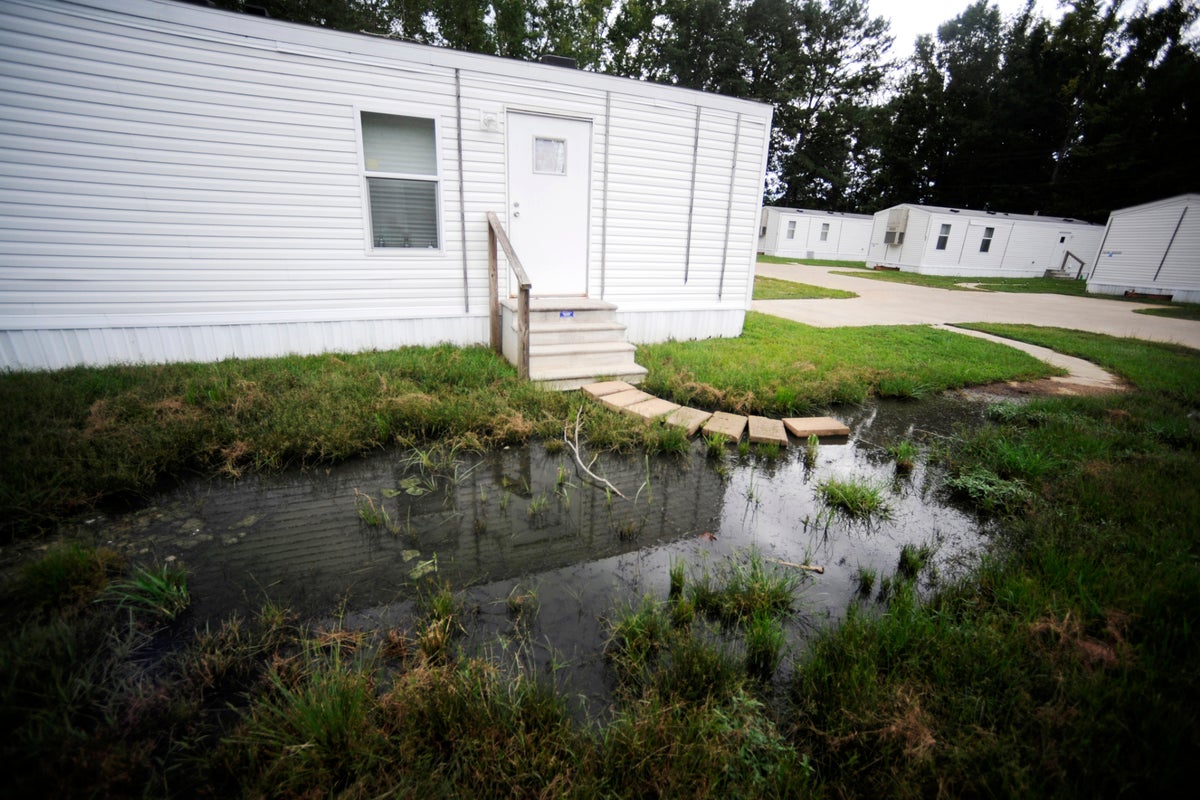As Congress barrels toward a government shutdown starting Sunday, a lapse in federal funding is poised to pause pay for thousands of federal workers in Alaska, while many government services could be hobbled.
If a shutdown happens, how long it will last and exactly how it will play out in Alaska is unclear.
Some federal agencies in Alaska, including those operating under the sprawling Interior Department, had not released specific plans as of Thursday.
But with just two days until government funding runs out, a fix appears less and less likely to arrive.
How will a shutdown affect Alaska’s federal employees?
Federally paid workers have a huge presence in Alaska, with its vast land ownership, 200-plus federally recognized tribes, and several military bases.
Alaska is home to 16,000 federal employees, state data shows. There are also 20,000 active-duty service members counted separately. Together, those workers represent a large portion of workers in the state
Many of those workers aren’t expected to be paid during a shutdown, though a 2019 law passed by Congress ensures they receive back pay when it’s over. Also, Alaska Republican Sen. Dan Sullivan is leading a bill to pay military personnel during the shutdown, but it was blocked Wednesday.
Oct. 13 will be the first day many federal workers miss paychecks, should the shutdown extend to that point.
Furloughed federal workers can sign up for unemployment compensation through the state, but they’re required to repay that money when they receive back pay, according to the Alaska Department of Labor and Workforce Development.
[Federal government starts notifying employees a shutdown may be imminent]
Federal employees who must continue working during the shutdown are not eligible for unemployment compensation, even if they’re not paid while working, since they’re not unemployed, the agency says.
A statement from Gov. Mike Dunleavy’s office said that 4,700 state executive branch positions are at least partially federally funded, but will see no disruption in pay and will report to work. The federal government will determine the status of federal employees who work in state of Alaska departments, the statement said.
What services will continue?
Despite the shutdown, several federal programs like Social Security, Medicare and veterans benefits should continue as usual.
Medicare is funded permanently, so benefits will not be affected by a shutdown. Medicaid would also operate for the time being since the program is funded for the next three months.
The Centers for Medicare and Medicaid Services could experience some administrative disruptions. According to the agency’s contingency plan, more than half of its staff will be furloughed, which could cause processing lags.
Like Medicare, Social Security is not subject to annual appropriations, so in the event of a shutdown the Social Security Administration would continue to send checks.
Veterans benefits like pensions and health care would also continue, and most of the Department of Veterans Affairs will keep working through a shutdown.
For food assistance, the Supplemental Nutrition Assistance Program will maintain operations through October, according to Shirley Sakaye with the Alaska Department of Health.
“If the shutdown goes beyond October, the feds have stated they will provide guidance to states,” Sakaye said by email.
Benefits for the Women, Infants and Children program “will be funded through December” using unspent funds, she said.
The U.S. Postal Service will still deliver mail uninterrupted during a shutdown, and all post offices will remain open. USPS is not funded through tax dollars, so it won’t be impacted by a shutdown.
[How a government shutdown would affect Medicare and Medicaid benefits]
Alaskans will be able to apply for passports from the U.S. Passport Agency, but with the agency facing furloughs and an already extensive backlog, securing a passport could take longer than usual.
The National Weather Service will continue operating its regular schedule, keeping up forecasts, warnings and observations, spokeswoman Maureen O’Leary said in an email. Also, critical functions such as radar repair will continue, she said.
But routine equipment maintenance, upgrades to forecast models and other longer-term improvements to service delivery will be delayed, she said.
As far as state services go, the statement on Tuesday from the governor’s office said Alaska is prepared to continue state-administered federally funded programs for 34 days — the length of the most recent shutdown that ended in 2019.
If a shutdown lasts longer than that, the state “will reevaluate the situation if necessary, and prioritize programs that most directly impact the life, health, and safety of Alaskans,” the governor’s office said.
Active-duty military operations, including search and rescue, will also continue through a shutdown even as service members miss paychecks.
What services might be paused?
A shutdown will likely lead to wide-ranging impacts, both big and small. Applications for social service programs could be stalled, permitting efforts could be put on hold, small-business loans could be delayed, and many federal contractors aren’t paid.
The White House this week said a shutdown will leave disaster relief programs underfunded, delaying 14 long-term recovery projects in Alaska, and many more in the U.S. The White House did not say which projects in Alaska would be affected. The Federal Emergency Management Agency did not respond to an email seeking comment.
[FEMA delays $2.8 billion in disaster aid to keep from running out of money]
The White House also said travel could be delayed during a shutdown as air traffic controllers and Transportation Security Administration agents work without pay, including about 730 such workers in Alaska.
Transportation Secretary Pete Buttigieg has also raised concerns that air traffic controllers in training will be furloughed, hamstringing the department’s efforts to fill a controller shortage.
During the 2019 partial shutdown that lasted five weeks, 10% of TSA agents nationally, who were not getting paid, called in sick, exacerbating delays.
Public meetings scheduled in Alaska while the government is shut down would also likely be canceled until it ends, federal officials say.
That includes two public meetings on the Biden administration’s environmental review of the oil and gas lease program in the Arctic National Wildlife Refuge. The first is set for Fairbanks on Monday.
Other federal meetings that could be canceled next week include subsistence regional advisory council meetings in Kenai and Arctic Village to discuss hunting and trapping regulations.
In Alaska, past shutdowns have also delayed permitting for commercial fishing boats, hobbled planning and preparation for wilderness firefighting efforts in Alaska, and led to closures or limited services at national parks, including those in Alaska.
What is Alaska’s congressional delegation doing?
The Alaska congressional delegation has said Congress should try to avoid a shutdown, though at this point, averting or blunting a lapse in appropriations appears unlikely.
Sen. Sullivan introduced the “Pay Our Military Act” to ensure members of the military will receive paychecks during a shutdown. His fellow Alaska Republican, Sen. Lisa Murkowski, and 14 other GOP senators have signed on.
Sullivan attempted to fast-track the bill on the Senate floor Wednesday.
“It’s pretty simple, in the event of a shutdown — and right now we are all working hard to make sure we avoid it — we need to make sure that the men and women who protect us get paid. That’s it,” Sullivan said on the Senate floor.
Sullivan made a similar attempt last week to pass a bipartisan bill treating Coast Guard pay like the rest of the military in the case of the shutdown. Due to the Coast Guard’s funding mechanism, during the shutdown ending in 2019, Coast Guard members were not paid alongside the rest of the military.
Both Sullivan-led bills have hit roadblocks from Democratic leadership.
Alaska Democratic Rep. Mary Peltola signed onto similar Coast Guard legislation in the House.
This week, the Senate also began work on a 45-day short-term funding measure. Murkowski and Sullivan have supported two procedural Senate votes this week to advance a spending plan.
But if the Senate bill passed in its current form, it’s likely dead on arrival in the House. House Republican leadership has floundered while trying to pass their own short-term spending legislation to avoid a shutdown.
Peltola is in Alaska taking time to grieve the loss of her late husband, Eugene “Buzzy” Peltola Jr., who died in a plane crash earlier this month.
Peltola spokesman Sam Erickson said Peltola is receiving updates from the House floor and she will be prepared to return to D.C. if her vote is necessary to avert a shutdown.
What are the potential economic impacts for Alaska?
Neal Fried, a recently retired state economist, said the federal workforce in Alaska is large and well-compensated.
Delayed payment of their wages won’t damage the economy if the shutdown lasts a short period, as they typically have in the past, he said.
“But if it drags on for months, it will obviously be felt in the economy,” he said.
Federal civilian employees averaged about $90,000 in pay last year, compared to about $65,000 for the average Alaskan, he said.
Jonathan King, an economist who owns Halcyon Consulting in Anchorage, said a prolonged shutdown will be stressful for people who don’t collect paychecks.
He said a shutdown could temporarily lead to less spending in the economy, but it shouldn’t cause long-term economic impacts in part because workers will receive back pay.
“The bigger economic effects are the lost productivity,” he said. “Environmental impact statements won’t get reviewed. Permits won’t get issued. So that’s sort of the hidden effect, the work that doesn’t get done in those periods.”
Non-essential federal employees reached for this article said that if a shutdown begins on Sunday, they expected to receive an email Monday explaining that they would not be permitted to work during the shutdown.
Daily News reporter Annie Berman contributed to this report.

:quality(70)/cloudfront-us-east-1.images.arcpublishing.com/adn/TCOT3HSBZJCTHKCPX2WRGTYTEQ.JPG)
























